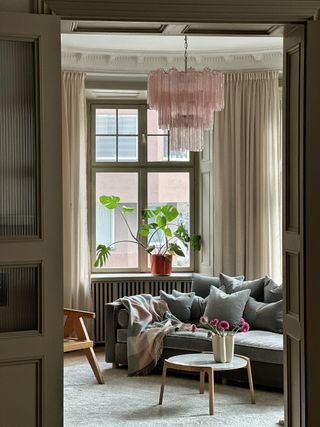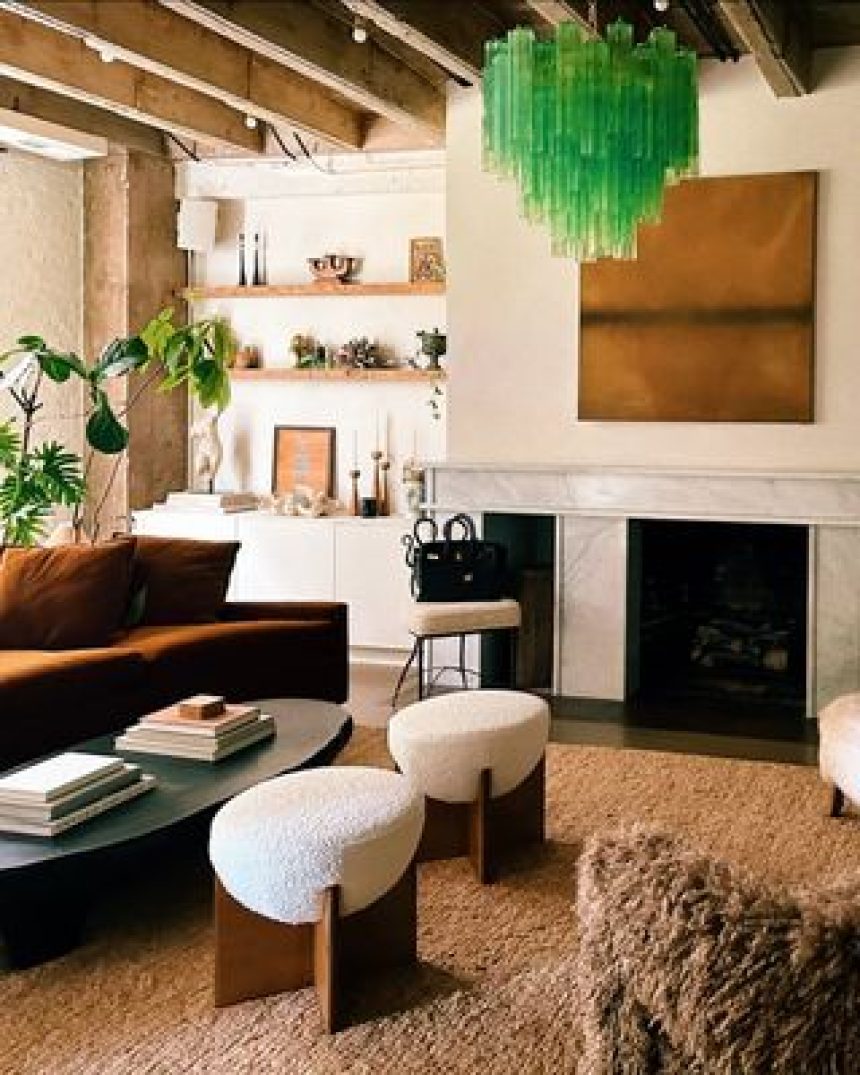Sometimes, you see a space online and it sits with you, way after the fact. That’s how I felt when I came across the New York loft apartment of fashion designer Hogan McLaughlin online a few months back — I knew I wanted to talk to someone about it.
At its center, something of an anomaly. Among the palette of rich and luxurious yet neutral colors of the apartment, a spectacular bright green, tiered chandelier, made from Murano glass. It’s an explosive statement piece.
This style of Murano glass chandelier itself is a design classic, but now I’m seeing it in a new light, and seeing it everywhere I look. It’s undoubtedly a case of the Baader-Meinhof phenomenon — now that I’ve taken particular notice of this lighting fixture, I can’t help but spot it, right? However, I have reason to believe this lighting trend is not just all in my head.
According to 1stDibs annual trends report, in which it polls its prestigious interior designer members, online marketplace, Murano-glass pendants and chandeliers are on the uptick, and are expected to be the most popular iconic vintage lighting in 2025 by a majority of respondents, beating out other design classics such as the Noguchi Akari lamp (the crowning champion last year).
To drill down into what these Murano fixtures say about the mood in decorating now, I spoke to Hogan about this bright-green wonder, as well as an expert in Murano glass to help you find exactly what you’re looking for to bring this trend home.
(Image credit: Hogan McLaughlin)
Hogen tells me the vibrancy of the green was a happy accident. The apartment, which Hogan shares with partner Bill Crisafi, has a lofty, industrial feel that the couple wanted to soften, and they already knew they loved the handmade look of Murano glass from previously owning a Murano sconce at an old condo, so began to look towards larger, tiered chandeliers.
“We try to be very intentional with how we use color when designing our spaces, since most of our taste tends towards neutrals and earth tones,” the fashion designer tells me. We were initially looking at clear or amber glass, but we saw this one and knew green was the way to go. Funny enough, this was not the color we ordered. “We had purchased the chandelier in olive green, but the company accidentally sent it to us in this absinthe green glass instead. They were very accommodating and corrected the mistake, but also let us keep what they had already sent, so we are now able to switch out the glass whenever we feel like a little change. We really fell in love with the absinthe color the longer we sat with it, and it’s such a conversation piece whenever we have guests over. Bill thinks it looks like the Emerald City turned upside down, and I think it looks like Minas Morgul from Lord of the Rings.”
Yes, it’s been a big year for decorating with green — everything from Brat summer to Wicked has cemented various, bolder-than-we’re-used-to shades of the color as a defining mood of the moment. And, it feels particularly right in this tiered chandelier format. “I think it brings both a softness and a boldness,” Hogan says. “It energizes the room but at the same time it somehow organically blends in with the plants and greenery. It feels like its own set of dripping vines growing from the ceiling.”
There’s something both timeless and decidely modern about this style of tiered chandelier, especially in contrast more familiar classical silhouette. It’s a combination of material meeting form (and in this case, color) in an exciting and dynamic way.
Why is Murano glass trending?

(Image credit: Hogan McLaughlin)
You’ll find standard glass chandeliers in similar styles to Murano ones (in fact, Soho Home’s green Chiara Chandelier is a near match for Hogan’s living room lighting albeit it with ombre colored glass), so while these poetically-shaped fixtures might be a catalyst for this material’s revival, it’s not just about their design. Murano glass has not only a level of prestige that makes it desirable by the higher end of the market, but also an special, inimitable quality that sets it apart.
Murano glass, if you’re not familiar, refers to glass crafted on Murano, an island just outside Venice in Italy. “Glass has been created and developed here since the 13th century,” says Lina Laurin, founder of Studio Laurin, a retailer specializing in Murano glass chandeliers. “The tradition is strong, and Murano glass is still handmade by glass makers since many generations with the skills and professionalism that has been passed down for centuries. The level of craftsmanship is a central aspect of Murano glass which ensures the high quality and special glow.”
There’s a distinct texture to it, that can help you identify the real deal. It’s handmade, so there’s an irregularity and a roughness to it, and you’ll be able to spot bubbles in the glass across layers. It has a depth and feel that gives an idea of the human touch involved, giving the resulting lighting, vases, and more, a sense of soul.
This provenance does, however, often come with a price tag reflecting its prestige, with chandeliers in Murano glass selling for thousands and thousands of dollars.
What are the different types of Murano glass chandelier?
Murano chandeliers come in a variety of forms, but it’s these tiered styles that are capturing our collective imagination right now. However, there are a few different tiered designs to know about that can help you source the style you’re looking for in particular.
Hogan’s, for example, is a style called the Tronchi, with its delicate flower-shaped tubes. Below, our Murano expert Lina Laurin, outlines the silhouettes you need to know about.
1. POLIEDRI

The Poliedri is a shallow tiered glass chandelier with angular, jewel-like polihedrons. “The Poliedri prism was launched by Venini at the 1958 Brussels World’s Fair,” Lina explains, “designed by Ignazio Gardella, Paolo Venini and Enrico Peresutti.”
“The same prism was used for the famous cascade CHANDELIER created by Venini with Carlo Scarpa and proposed at the Turin “Italia ‘61” Expo,” Lina adds.
2. TRONCHI

“The modernist mid-century Tronchi chandelier with tube formed prisms was created by Tony Zuccheri for Venini during the 1960s,” Lina says. These long glass tubes, often seen in colorful finishes, have a subtle flower shape.
3. MURANO PETAL

With its flared glass petals, this style of chandelier is pretty and elegant.
“The ‘Murano petal’ was launched in the 1960s by a group of glass-workers in Murano who called themselves La Murrina,” Lina explains. “It took decades though before “La Murrina” trademark was registered all around the world.”
4. DROP

“The ‘Murano Drop’ prism has been made of various glassmakers since the 1970s,” Lina tells me. Like oversized raindrops, they offer a soft, fluid look to the chandelier.
Whichever style of tiered chandelier you’re drawn to, they share a design language that I’m predicting we’ll see more of than ever next year. However, don’t think of it as a fleeting trend — these timeless designs have been popular for decades, and there’s no doubt they’ll continue to be for time to come.






